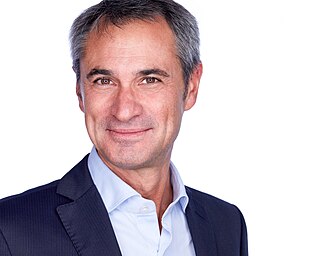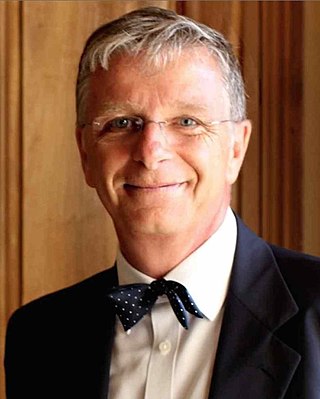
The École polytechnique fédérale de Lausanne is a public research university in Lausanne, Switzerland. Established in 1853, EPFL has placed itself as a university specializing in engineering and natural sciences.
The Latsis Foundation is a charitable foundation, founded in 1975 by the Greek shipping magnate John Latsis.

Francesco Mondada is a Swiss professor in artificial intelligence and robotics. He got a Master's degree in Microengineering at the EPFL in 1991 and a PhD degree in 1997. He is one of the creators of the Khepera and directed the design of the S-bot, the e-puck, the marXbot and the Thymio mobile robots. Together, these robots are mentioned in more than 9000 research articles. In particular the Khepera robot is a milestone in the field of bio-inspired and evolutionary robotics.

Dario Floreano is a Swiss-Italian roboticist and engineer. He is director of the Laboratory of Intelligent System (LIS) at the École Polytechnique Fédérale de Lausanne in Switzerland and was the founding director of the Swiss National Centre of Competence in Research (NCCR) Robotics.

Patrick Aebischer has been the president of the École polytechnique fédérale de Lausanne (EPFL) from 17 March 2000 to 31 December 2016. He is also a professor in neuroscience and head of the Neurodegenerative Disease Laboratory at the EPFL.

The Dalle Molle Institute for Artificial Intelligence Research is a research institution based in Lugano, in Canton Ticino in southern Switzerland. It was founded in 1988 by Angelo Dalle Molle through the private Fondation Dalle Molle. In 2000 it became a public research institute, affiliated with the Università della Svizzera italiana and SUPSI in Ticino, Switzerland. In 1997 it was listed among the top ten artificial intelligence laboratories, and among the top four in the field of biologically-inspired AI.
Alain Wegmann was a Swiss computer scientist, professor of Systemic Modeling at the École Polytechnique Fédérale de Lausanne (EPFL), and Information Technology and Services consultant, known for the development of the Systemic Enterprise Architecture Methodology (SEAM).

The Rolex Learning Center is the campus hub and library for the École polytechnique fédérale de Lausanne (EPFL), in Lausanne, Switzerland. Designed by the winners of 2010 Pritzker Prize, Japanese-duo SANAA, it opened on 22 February 2010.
The Dalle Molle Institute for Semantic and Cognitive Studies is a research institute in Geneva, Switzerland. It was founded in Lugano in 1972 by Angelo Dalle Molle through the Fondation Dalle Molle, to conduct research into the application of artificial intelligence to linguistics, cognitive science and semantics with the aim of developing systems for automated translation. Since 1976 it has been a part of the Faculté de Traduction et d'Interprétation, the faculty of translation and interpreting, of the University of Geneva.

The Lausanne campus or Dorigny university campus is a large area in Switzerland where the University of Lausanne (UNIL), the École polytechnique fédérale de Lausanne (EPFL) and several other institutions are located. It is in Dorigny, towards the west of Lausanne, on the shores of Lake Geneva. The site is about 2.2 kilometres wide and 31,000 people study and work there.
The Health Valley covers the Western Switzerland region, where the life sciences sector extends from Geneva to Bern, including the seven cantons of Bern, Fribourg, Geneva, Jura, Neuchâtel, Valais and Vaud. This cluster presents a critical mass of 1,000 companies, research centers and innovation support structures, representing today more than 25,000 employees. The Health Valley strives to animate the life sciences ecosystem of the region, by establishing thriving bridges between its ambassadors.

Angelo Dalle Molle was an Italian businessman and Utopian philanthropist. In 1952 he invented and patented Cynar, a bitter aperitivo based on artichoke leaves.
Alcherio Martinoli is a roboticist and an associate professor at the École polytechnique fédérale de Lausanne (EPFL) in the School of Architecture, Civil and Environmental Engineering where he heads the Distributed Systems and Algorithms Laboratory.

Hubert Girault (born 13 February 1957 in Saint-Maur-des-Fossés, France) is a Swiss chemist and is Emeritus Professor at the École Polytechnique Fédérale de Lausanne (1992-2022). He was the director of the Laboratoire d'Electrochimie Physique et Analytique, with expertise in electrochemistry at soft interfaces, Lab-on-a-Chip techniques, bio-analytical chemistry and mass-spectrometry, artificial water splitting, CO2 reduction, and redox flow batteries.
Sabine Süsstrunk is a computer scientist and professor at Ecole Polytechnique Fédérale de Lausanne (EPFL) in Switzerland, where she leads the Images and Visual Representation Lab in the School of Computer and Communication Sciences. Her research areas are in computational imaging and computational photography, color image processing and computer vision, and image quality and computational aesthetics. She is a fellow of the Institute of Electrical and Electronics Engineers and Society for Imaging Science and Technology and received the Society of Imaging Science and Technology and International Society for Optics and Photonics 2013 Electronic Imaging Scientist of the Year Award.

Sabine Hauert is Professor of Swarm Engineering in the Bristol Robotics Laboratory at the University of Bristol where her research investigates swarm robotics. Previously she worked at the Massachusetts Institute of Technology (MIT), Carnegie Mellon University (CMU) and the École Polytechnique Fédérale de Lausanne (EPFL) in Switzerland.

Erna Hamburger was a Swiss engineer and professor. In 1957, she became professor of electrometry at the University of Lausanne. She was the first woman in the history of Switzerland to be named a professor at a STEM university.
SwissCovid is a COVID-19 contact tracing app used for digital contact tracing in Switzerland. Use of the app is voluntary and based on a decentralized approach using Bluetooth Low Energy and Decentralized Privacy-Preserving Proximity Tracing (dp3t).

Claudia R. Binder is a Swiss, Canadian and Colombian environmental scientist working in the field of human-environment systems and sustainability s. Since March 2016 she has been a full professor the La Mobilière Chair on Urban Ecology and Sustainable Living at École polytechnique fédérale de Lausanne (EPFL) in Switzerland and founding director of the Laboratory for Human-Environment Relations in Urban Systems (HERUS) at School of Architecture, Civil and Environmental Engineering (ENAC) of EPFL. Since January 2020 she has been serving as dean of ENAC at EPFL.












